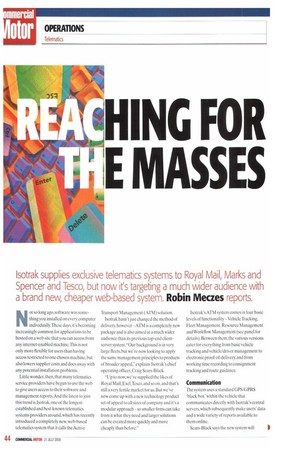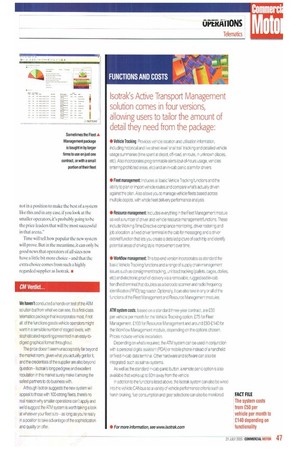HING FOR MASSES
Page 44

Page 46

Page 47

If you've noticed an error in this article please click here to report it so we can fix it.
Isotrak supplies exclusive telematics systems to Royal Mail, Marks and Spencer and Tesco, but now it's targeting a much wider audience with a brand new, cheaper web-based system. Robin Meaes reports.
Not so long ago, software was something you installed on every computer individually.lbese days, it's becoming increasingly common for applications to be hosted on a web site that you can access from any internet-enabled machine. This is not only more flexible for users than having access restricted to one chosen machine, but also lowers supplier costs and does away with any potential installation problems.
Little wonder, then, that many telematics service providers have begun to use the web to give users access to their software and management reports. And the latest to join this trend is Isotrak, one of the longestestablished and best-known telematics systems providers around, which has recently introduced a completely new, web-based telematics system that it calls the Active Transport Management (ATM) solution.
Isotrak hasn't just changed the method of delivery, however —ATM is a completely new package and is also aimed at a much wider audience than its previous top-end clientserver system. "Our background is in very large fleets, but we're now looking to apply the same management principles to products of broader appeal," explains Isotrak's chief operating officer, Craig Sears-Black.
"Up to now, we've supplied the likes of Royal Mail, Exel,Tesco, and so on, and that's still a very fertile market for us. But we've now come up with a new technology product set of appeal to all sizes of company and it's a modular approach —so smaller firms can take from it what they need and larger solutions can be created more quickly and more cheaply than before." Isotrak's ATM system conies in four basic levels of functionality —Vehicle Tracking, Fleet Management, Resource Management and Workflow Management (see panel for details). Between them, the various versions cater for everything from basic vehicle tracking and vehicle/driver management to electronic proof-of-delivery, and from working time recording to consignment tracking and route guidance.
Communication
The system uses a standard GPS/GPRS 'black box' within the vehicle that communicates directly with Isotrak's central servers, which subsequently make users' data and a wide variety of reports available to them online.
Sears-Black says the new system will completely replace the older client-server based solution in time and that lsotrak has already begun approaching all its customers about upgrading.
Although aimed pre-dominantly at firms with medium-sized (100-vehicles plus) fleets. the system can also be used by operations with fewer vehicles, he adds, "For example. Exel uses it for an operation for Staples on one particular site where it covers around 14 vehicles, and TDG uses it across three sites for 65 vehicles on a Halfords operation," he says."Both of those are using the Fleet Management version, and Sainsbury also uses the basic Vehicle Tracking package to track around 20 trailers in Northern Ireland."
Progression Most ATM users so far are on one of these two more basic versions, he admits — in fact nobody, as yet, has progressed to the top-end Workflow Management module —hut Sears-Black suggests it's only a question of time. "As we thought, people like to start with the basic vehicle tracking and we're then migrating them upwards. Staples, for instance, started with Vehicle Tracking and has already moved up to Fleet Management and in time, we expect them to move to Resource Management, too. In fact we generally recommend people start with Vehicle Tracking to understand how things work and see what's going on, and then buildup from there."
Sears-Black admits that Isotrak is far from the first telematics provider to harness the potential of the internet in this way, but says there were good reasons for holding off until now. "We didn't want Lobe 'bleeding edge' about i t.We could have done this, theoretically, about three years ago.
-The technology was there — but it wasn't quite mature enough. For example. GPRS modems didn't work all that reliably back then.The web itself has also become more reliable in between and 111 * internet service providers [ISPs] have also a become more robust. So we believe that now is the right time to start the migration."
All well and good. But what differentiates isotrak's product offering from every other web-based telernatics system out there?
The answer, says Sears-Black, is all about service and quality. "This hasn't been put together with string and sticky tape — which is what a lot of other people are doing. It's one of the problems in the market. You can put a basic GPS system together in a garage, but you can't run it in a suitable way for logistics and transport operations to base their activities on and a lot of systems out there are just not up to the job in terms of reliability and robustness. We have service level agreements with extremely high uptime— in fact we guarantee our system is available in excess of 99% of the time, with very strict rules around that."
Sophistication
Part of that reliability comes from two new data centres established late last year in Milton Keynes and Theale."The investment was absolutely huge,says Sears-Black. -We're not a price leader and we never have been and that's one of the reasons."
It's also one of the reasons that Isotrak's solution is more likely to appeal to firms of a certain level of sophistication, he says."We do have a few customers on the smaller side, but we're getting most engagement from businesses that are already well organised and well controlled but are looking to go to the next stage. Small companies are, mostly, not in a position to make the best of a system like this and in any case, if you look at the smaller operators, it's probably going to be the price leaders that will be most successful in that arena."
Time will tell how popular the new system will prove. But in the meantime, it can only be good news that operators of all sizes now have a little bit more choice and that the extra choice comes from such a highly regarded supplier as Isotrak. •


































































































































































































